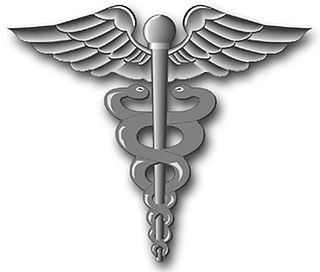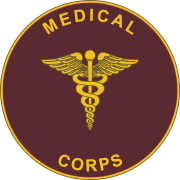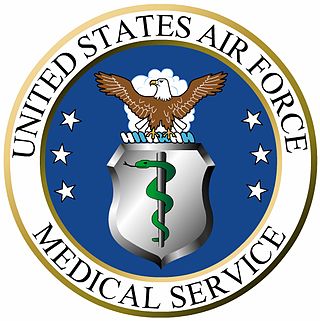Surgeon general (PL: surgeons general) is a title used in several Commonwealth countries and most NATO nations to refer either to a senior military medical officer or to a senior uniformed physician commissioned by the government and entrusted with public health responsibilities. The title originated in the 17th century, as military units acquired their own physicians.
In the United Kingdom, the Surgeon-General is the head of the military medical services. The post is held by the senior of the three individual service medical directors and carries the rank of vice admiral, lieutenant general, or air marshal.
In the United States, the chief public health officer is the Surgeon General of the United States, and a small number of states have state surgeons general. Moreover, three of the U.S. military services have their own surgeon general, namely the Surgeon General of the United States Army, Surgeon General of the United States Navy, and Surgeon General of the United States Air Force.

A flight surgeon is a military medical officer practicing in the clinical field of aviation medicine. Although the term "flight surgery" is considered improper by purists, it may occasionally be encountered.
The United States has eight federal uniformed services that commission officers as defined by Title 10 and subsequently structured and organized by Titles 10, 14, 32, 33 and 42 of the U.S. Code.

The surgeon general of the United States is the operational head of the United States Public Health Service Commissioned Corps (PHSCC) and thus the leading spokesperson on matters of public health in the federal government of the United States. The Surgeon General's office and staff are known as the Office of the Surgeon General (OSG), which is housed within the Office of the Assistant Secretary for Health.

Air commodore is a senior rank in the air forces of the United Kingdom and other countries including Australia, New Zealand, India, Pakistan and Zimbabwe. It is a one-star rank and is an air officer rank. It originated in, and continues to be used by the Royal Air Force.

The United States Public Health Service Commissioned Corps (PHSCC), also referred to as the Commissioned Corps of the United States Public Health Service, is the federal uniformed service of the U.S. Public Health Service (PHS) and one of the eight uniformed services of the United States. The commissioned corps' primary mission is the protection, promotion, and advancement of health and safety of the general public.
The Flight Surgeon Badge is a military badge of the United States Armed Forces which has existed to designate Flight Surgeons since the Second World War.

Uniformed Services University of the Health Sciences (USU) is a health science university of the U.S. federal government. The primary mission of the school is to prepare graduates for service to the U.S. at home and abroad in the medical corps as medical professionals, nurses, and physicians.

The Medical Corps of the United States Navy is a staff corps consisting of military physicians in a variety of specialties. It is the senior corps among all staff corps, second in precedence only to line officers. The corps of commissioned officers was founded on March 3, 1871.

Identification badges of the Uniformed Services of the United States are insignia worn by service members conducting special duties, many of which can be awarded as permanent decorations if those duties are performed successfully. There are a few identification badges that are awarded to all services, others are specific to a uniform service. The Office of the President and Vice President and department/service headquarters badges are permanent decorations for those who successfully serve in those assignments. Some of the service level identification badges can be permanent decorations and others are only worn by a service member while performing specific duties, such as the Military Police Badge.

A hospital corpsman is an enlisted medical specialist of the United States Navy, who may also serve in a U.S. Marine Corps unit. The corresponding rating within the United States Coast Guard is health services technician (HS).

The Army Medical Department of the U.S. Army (AMEDD), formerly known as the Army Medical Service (AMS), encompasses the Army's six medical Special Branches. It was established as the "Army Hospital" in July 1775 to coordinate the medical care required by the Continental Army during the Revolutionary War. The AMEDD is led by the Surgeon General of the U.S. Army, a lieutenant general.

The Medical Corps (MC) of the U.S. Army is a staff corps of the U.S. Army Medical Department (AMEDD) consisting of commissioned medical officers – physicians with either an M.D. or a D.O. degree, at least one year of post-graduate clinical training, and a state medical license.
The Health Professions Scholarship Program (HPSP) offers prospective military physicians, dentists, nurses, optometrists, psychologists, pharmacists, and veterinarians a paid professional education in exchange for service as a commissioned non-line or special branch officer. Programs are available in the United States Army, the United States Navy, and the United States Air Force.

The United States Air Force Medical Service (AFMS) consists of the five distinct medical corps of the Air Force and enlisted medical technicians. The AFMS was created in 1949 after the newly independent Air Force's first Surgeon General, Maj. General Malcolm C. Grow (1887–1960), convinced the United States Army and President Harry S. Truman that the Air Force needed its own medical service.

The Surgeon General of the United States Army is the senior-most officer of the U.S. Army Medical Department (AMEDD). By policy, the Surgeon General (TSG) serves as Commanding General, U.S. Army Medical Command (MEDCOM) as well as head of the AMEDD. The surgeon general's office and staff are known as the Office of the Surgeon General (OTSG) and are located in Falls Church, Virginia.

Gale S. Pollock is a retired United States Army major general who served as the Deputy Surgeon General of the United States Army from October 2006 to March 2007, and also as chief of the Army Nurse Corps. She became acting Surgeon General of the United States Army for nine months following the 20 March 2007 retirement of her predecessor, Kevin C. Kiley, due to fallout from the Walter Reed Army Medical Center neglect scandal. She was the first woman and the first non-physician to hold the position.

The term military medicine has a number of potential connotations. It may mean:

A Senior Enlisted Advisor (SEA) in the United States Armed Forces is the most senior enlisted service member in a unit, and acts as an advisor to the commanding officer. Formally, E-9 billets for the senior enlisted advisor are established at Service unit, command, major command, force, or fleet levels to the SEAs/CSELs of DoD Agencies and the Senior Enlisted Advisor to the Chairman of the Joint Chiefs of Staff. SEAs are also known as Command Senior Enlisted Leaders (CSEL). Always a non-commissioned officer, the SEA is the main link between the commanding officer and the enlisted service members under his or her charge.
The Surgeon General is the professional head of the Canadian military health jurisdiction, the adviser to the Minister of National Defence and the Chief of Defence Staff on all matters related to health, and head of the Royal Canadian Medical Service. The Surgeon General may also be appointed the commander of the Canadian Forces Health Services Group, which fulfils all military health system functions from education and clinical services to research and public health. It consists of the Royal Canadian Medical Service, the Royal Canadian Dental Corps, personnel from other branches of the armed forces, and civilians, with health professionals from over 45 occupations and specialties in over 125 units and detachments across Canada and abroad. When appointed Director General Health Services, the Surgeon General is also the senior health services staff officer in the Department of National Defence. The Surgeon General is normally appointed to the Medical Household as Honorary Physician (QHP) or Honorary Surgeon (QHS) to Her Majesty the Queen.
Captain is a title, an appellative for the commanding officer of a military unit; the supreme leader of a navy ship, merchant ship, aeroplane, spacecraft, or other vessel; or the commander of a port, fire or police department, election precinct, etc. In militaries, the captain is typically at the level of an officer commanding a company or battalion of infantry, a ship, or a battery of artillery, or another distinct unit. The term also may be used as an informal or honorary title for persons in similar commanding roles.














